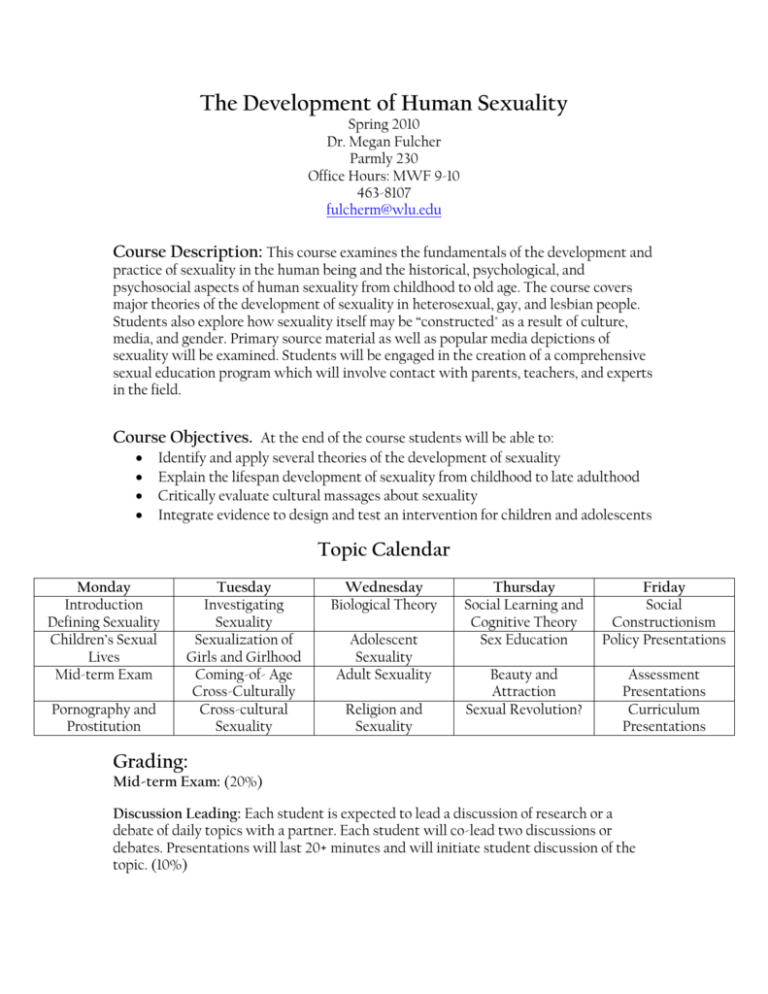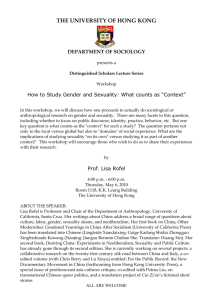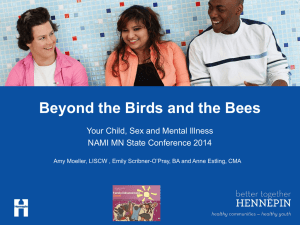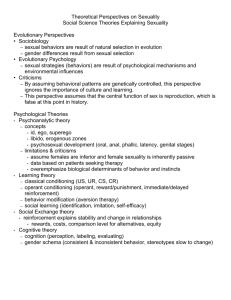
The Development of Human Sexuality
Spring 2010
Dr. Megan Fulcher
Parmly 230
Office Hours: MWF 9-10
463-8107
fulcherm@wlu.edu
Course Description: This course examines the fundamentals of the development and
practice of sexuality in the human being and the historical, psychological, and
psychosocial aspects of human sexuality from childhood to old age. The course covers
major theories of the development of sexuality in heterosexual, gay, and lesbian people.
Students also explore how sexuality itself may be “constructed" as a result of culture,
media, and gender. Primary source material as well as popular media depictions of
sexuality will be examined. Students will be engaged in the creation of a comprehensive
sexual education program which will involve contact with parents, teachers, and experts
in the field.
Course Objectives. At the end of the course students will be able to:
Identify and apply several theories of the development of sexuality
Explain the lifespan development of sexuality from childhood to late adulthood
Critically evaluate cultural massages about sexuality
Integrate evidence to design and test an intervention for children and adolescents
Topic Calendar
Monday
Introduction
Defining Sexuality
Children’s Sexual
Lives
Mid-term Exam
Pornography and
Prostitution
Tuesday
Investigating
Sexuality
Sexualization of
Girls and Girlhood
Coming-of- Age
Cross-Culturally
Cross-cultural
Sexuality
Wednesday
Biological Theory
Adolescent
Sexuality
Adult Sexuality
Religion and
Sexuality
Thursday
Social Learning and
Cognitive Theory
Sex Education
Friday
Social
Constructionism
Policy Presentations
Beauty and
Attraction
Sexual Revolution?
Assessment
Presentations
Curriculum
Presentations
Grading:
Mid-term Exam: (20%)
Discussion Leading: Each student is expected to lead a discussion of research or a
debate of daily topics with a partner. Each student will co-lead two discussions or
debates. Presentations will last 20+ minutes and will initiate student discussion of the
topic. (10%)
Mini-project: Each student will complete a mini-project which applies the topic of the
day to real-life observations. The project will be accompanied by a 5 page paper. (10%)
Cross-Cultural Work: Each student will present information to the class about the
sexuality values, beliefs and practices of another culture. (5%)
Sex Education Project: Each student will work with a group to create a pilot
comprehensive sex education program for elementary school, middle school, or high
school students. The project includes three phases:
Policy: The group must design a policy presentation for parents and school board
that convinces them of the need for such a program. The presentation should
highlight a few of the curricular ideas that the group is working on. It should
include a special focus on girls’ agency, and gay and lesbian youth. (15%)
Assessment: The group must design a research project that will assess the
effectiveness of their curricular program. They should write this proposal in APA
format. (15%)
Curriculum: The group will present their curriculum plan to the class. These
plans should include activities and media, lecture notes, lesson plans, and plan for
parent involvement. (20%)
Participation: Each person is expected to add to a productive and respectful
conversation in class during each meeting. (5%)
Out of Class Work: Participation and Project grades include participation in events
outside of class time. These events include a Parents’ Panel, Community Health Care
Providers’ Panel and Teachers’ Panel in which students are expected to interview
teachers and parents as they prepare the sex education project.
Reading and Project Requirements:
Week One: Theory and Method
Monday: Introduction and Defining Sexuality
Tuesday: Investigating Sexuality
Centers for Disease Control, (2005). Survey of American Sexual Behaviors.
What trends did you notice?
What surprised you?
Do you think they did a good job measuring sexuality?
Wednesday: Biological Theory
De Waal, F.B.M. (1995). Bonobo sex and society: The behavior of a close relative
challenges assumptions about male supremacy in human evolution. Scientific American, 8288.
Jolly, A. (1999). Human apes. Lucy’s legacy: Sex and intelligence in human evolution.
Cammbridge: Mass. Harvard University Press. (56-65)
Thursday: Social Learning and Cognitive Theory
Hogben, M. & Donn, D. (1998). Using social learning theory to explain individual
differences in human sexuality.(The Use of Theory in Research and Scholarship on
Sexuality). The Journal of Sex Research, 35, 58-72.
Hyde, J.S. & Jafee, S.R. (2000). Becoming a heterosexual adult: The experiences of
young women. Social Issues, 56 (2), 283-296.
Discussion Paper:
Ward, M. (1995).Talking about sex: Common themes about sexuality in the
prime-time television programs children and adolescents view most. Journal of Youth and
Adolescents, 24 (5), 595- 615.
Friday: Social Constructionism
Bem, D.J. (1996). The exotic becomes erotic: A developmental theory of sexual
orientation. Psychological Review, 103, 320-335.
Peplau, L.A., Garnets, L.D., Spalding, L.R., Conley, T.D., & Veniegas, R.C. (1998).
Critique of Bem’s “Exotic becomes erotic” Theory of Sexual Orientation. Psychological
Review, 105 (2), 387-394.
Bem, D.J. (1998). Is EBE Theory supported by evidence? Is it androcentric? A reply
to Peplau et al. Psychological Review, 105 (2), 395-398.
Discussion Paper:
Rich, A. (1980). Compulsory heterosexuality and lesbian existence.
Week 2: Children and Adolescent Sexuality
Monday: Children’s Sexuality
Larsson, I.B. & Svedin C. G. (2002). Teachers’ and Parents’ reports on 3-6 year old
children’s sexual behavior: a comparison. Child Abuse& neglect, 26, 247-266.
Volpert, R. (2000). Sexual Knowledge of Preschool Children. Journal of Psychology
and Human Sexuality, 12, 5-26.
Mini-project: Disney Movie
Strasburg, V.C. & Wilson, B. J. (2002). Sexuality and the media. Children, Adolescents, & the
Media. Sage: Thousand Oaks. 145-193.
Tuesday: Sexualization of Girls and Girlhood
O'Donohue, W.; Gold, S. R., & McKay, J. S. (1997). Children as Sexual Objects:
Historical and Gender Trends in Magazines. Sexual Abuse: A Journal of Research and
Treatment, Vol. 9.
Fredrickson, B.L. & Roberts T-A (1997) Objectification Theory: Toward
understanding women’s lived experiences and mental health risks. Psychology of Women
Quarterly, 21, 173-206.
Wednesday: Adolescent Sexuality
Hirschman, C., Impett, E.A., & Schooler,D. (2006). Dis/embodied voices: What
late-adolescent girls can teach us about objectification and sexuality. Sexuality Research &
Social Policy,3, 8-20.
Weinburg, M.S., Williams, C.J., & Pryor, D.W. (1994). Becoming bisexual. Dual
attractions: Understanding bisexuality. Oxford University Press.
Thursday: Sex Education
Lehr, S. T., Demi, A.S., DiIorio, C., & Facteau, J. (2005). Predictors of Father-Son
Communication About Sexuality. Journal of Sex Research, 42(5), 119-129.
Blake, S.M., Ledsky, R. Lehman, T. Goodenow, C., Sawyer, R. & Hack, T. (2001).
Preventing sexual reisk behaviors among gay, lesbian and bisexual adolescents: The
benefits of gay-sensitive HIV instruction in schools. American Journal of Public Health,91, 940946.
Hartley, H. & Drew, T. (2001). Gendered messages in sex ed films: Trends and
implications for female sexual problems. Women & Therapy, 24, 133-146.
Discussion Article:
Horne, S. & Zimmer-Gembeck, M.J. (2005). Female sexual subjectivity and wellbeing: Comparing late adolescents with different sexual experiences. Sexuality Research &
Social Policy, 2, 25-40.
Friday: Policy Presentations
Week 3:Adult Sexuality
Monday: Mid-term Exam
Tuesday: Cross-Cultural Coming of Age
Malinowski, B. (1929). Prenuptial intercourse between the sexes. The sexual lives of
savages in north-western Melaesia. Boston: Beacon Press.
Blackwood, E. (2000). Culture and Women’s Sexualities. Journal of Social Issues,
56(2), 223-238.
Debate: Clitoridectomy: mutilation or tradition?
Wednesday: Adult Sexuality
Daniluk, J.C. (2003). Creating a life. Women’s Sexuality Across the Lifespan. Guilford
Press: NY. Pp 163-185.
Kurdek, L.A. (2005). What do we know about gay and lesbian couples? Current
Directions in Psychological Science, 14, 251- 254.
Mini Project: Romance Novels
Thursday: Beauty and Attraction
Bronski, M. (1998). The eroticized male body. The Pleasure Principle. St. Martin’s
Press.
Paley, M. (2004) The size question. The book of the penis. Grove Atlantic.
Mini Project: Media and Sexuality, Who is sexy?
Savacool (2004). Women’s ideal bodies then and now. Marie Claire, April 2004.
Friday: Assessment Presentations
Week 4: Cultural Images of Sex
Monday: Cross-cultural Sexuality
Continuum Complete International Encyclopedia of Sexuality (2004). Robert T.
Francoeur, Ph.D., and Raymond J. Noonan, Ph.D., Editors. The Continuum International
Publishing Group, New York and London
http://www.kinseyinstitute.org/ccies/
Tuesday:Religion and Sexuality
Yeoman, B. (1999). Gay no more. Psychology Today.
Matousek, M. (2004). Merry-go-round of desire. Tricycle, summer 2004.
Discussion Paper
Regnerus, M.D. (2005) Talking about Sex: Religion and patterns of parent-child
communication about sex and contraception. The Sociological Quarterly, 46, 79-105.
Wednesday: Pornography and Prostitution
Eck, B.A. (2003). Men are much harder: Gendered Viewing of nude images. Gender
& Society, 17, 691-710.
Jenefsky, C. & Miller, D.H. (1998). Girl-girl sex in Penthouse. Women’s Studies
International Forum, 21(4), 375-385.
Debate: Is Pornography bad for women?
Debate: Should Prostitution be illegal?
Thursday: Sexual Revolution?
Interview mini-project
Friday: Curriculum Presentations









